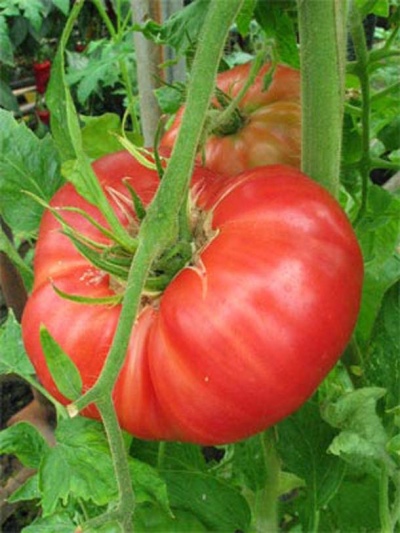
- Authors: Agrofirm "Seeds of Altai"
- Category: grade
- Growth type: determinant
- Appointment: fresh consumption
- Ripening period: mid-early
- Ripening time, days: 105-109
- Growing conditions: for open ground, for film greenhouses
- Bush size: undersized
- Bush height, cm: 55-75
- Bush characteristic: sprawling
For those who are not involved in rolling up numerous cans, preferring to grow tomatoes for fresh consumption, the Biyskaya rose variety is the best option. It is a salad option with a balanced flavor that can grow both in greenhouses and outdoors. In addition, juices of excellent quality are obtained from the fleshy fruits.
Breeding history
The authorship in the appearance of the variety belongs to the agricultural company "Seeds of Altai".
Description of the variety
The bushes of the Biysk rose are rather stunted - their height does not exceed 55, maximum 70 cm, while they are very spreading, which requires certain measures when growing.
The advantages of the variety:
large-fruited;
unpretentiousness;
good yield.
Disadvantages:
short storage time;
fresh use only;
tolerance to many diseases.
Strong shoots are capable of withstanding heavy clusters with 3-5 weighty fruits. At the same time, the tendency to scale forces gardeners to engage in the formation of a bush: 1-2 shoots are left in the open field, in greenhouse conditions up to 4 stems.
The main qualities of the fruit
Large (250-600 g) flat-round deep pink fruits can reach a record weight of 1 kg for a variety.
Taste characteristics
The juicy pulp has a dense structure and a pleasant sweetish taste with a slight sourness. The fruits are covered with a dense, but thin skin, almost imperceptible while eating. The few seed chambers contain a limited number of seeds.
Ripening and fruiting
Biysk rose refers to medium early tomatoes with extended fruiting: ripening period of 105-109 days, the harvest can be harvested during August-September, as the fruits ripen.
Yield
For bushes of such a small size, the yield indicators are considered high - if agrotechnical requirements are observed, up to 10-12 kg of fleshy and tasty tomatoes can be harvested from 1 square meter.
The timing of planting seedlings and planting in the ground
The variety is grown in seedlings, the seeds are sown in March, the grown seedlings are transplanted to a permanent place after about 60-65 days, in the phase of 6-7 true leaves and emerging flower brushes.

Growing tomato seedlings is an extremely important process, because it largely depends on whether the gardener will be able to harvest at all. All aspects must be taken into account, from seedbed preparation to planting in the ground.
Landing scheme
The optimal planting pattern of 40x40 cm, as a rule, is 2-3 roots per square meter.

Growing and care
An indispensable condition for growing tomatoes in Siberia is the seedling method.When growing seedlings, classical methods are used; young plants are transferred to a permanent place 2 months after sowing. Pre-"youngsters" are hardened, accustomed to low temperatures and bright sunlight. In the garden, areas are chosen that are well lit by the sun, the soil should be fertile, breathable, with a neutral pH level. Organic matter, mineral fertilizers, wood ash are added to the holes prepared for planting. After planting, the soil is compacted, well spilled with settled water at room temperature. If the plants are planted in open ground, at first they will need shading from the bright sun.
Further care for tomatoes consists of the following activities:
weeding;
regular watering;
loosening and hilling;
the formation of bushes, tying;
preventive treatments for diseases and pests.
In addition, fast-growing large-fruited plants require an increased amount of nutrients - those introduced in the spring are not enough to get a good harvest. During the set of vegetative mass, the tomatoes require nitrogen; during the budding period, it is necessary to feed with potassium-phosphorus compositions. Until the harvest ripens, tomatoes are fed with mullein and nettle infusions. Growing the Biysk rose in greenhouses also does not save gardeners from leaving. In order to avoid late blight, it is necessary to remove the lower leaves, and in those places where they are too thick. High humidity provokes the appearance of late blight and naked slugs. During the hot season, the greenhouse needs to be ventilated. The appearance of whiteflies and aphids threatens to inhibit the development of plants. No less dangerous for the bushes is the Colorado potato beetle, which over time has mastered not only potatoes, but also other nightshade crops, including tomatoes.




A plant needs different micronutrients at each stage of growth. All fertilizers can be divided into two groups: mineral and organic. Folk remedies are often used: iodine, yeast, bird droppings, eggshells.
It is important to observe the rate and period of feeding. This also applies to folk remedies and organic fertilizers.
Disease and pest resistance
The Biysk rose variety does not possess strong immunity and is tolerant to many traditional diseases of the nightshade group of plants, and is also subject to pest attacks. To avoid growing complications and diseases, it is necessary to treat the plants with insecticides and fungicides.


Resistant to adverse weather conditions
The plant, on whose appearance Siberian breeders worked, are adapted to the difficult conditions of the Siberian summer and are not afraid of temperature changes and tolerate short-term cold snaps well.
Growing regions
The tomato is intended for all regions of Siberia, and is also grown in the middle lane, in the Urals and the Far East.

























































































